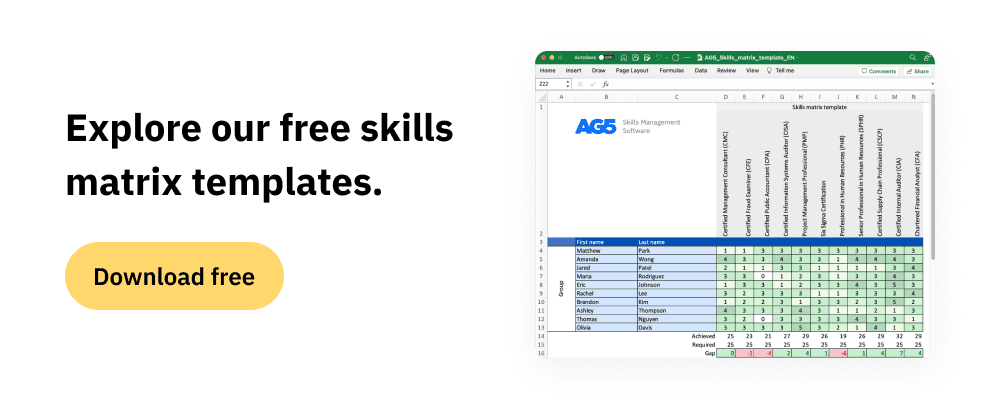8 recruitment planning mistakes to avoid
In this article, we discuss eight recruitment planning mistakes to avoid. It highlights common errors and provides guidance on how to steer clear of them for successful recruitment outcomes.

Recruitment costs too high? Attracting the wrong candidates? Want to be more proactive and less reactive? A recruitment plan is the answer. This article explains how to avoid 8 common recruitment strategy mistakes.
So, what is a recruitment plan exactly?Copied
Reactive organizations start looking for new hires after someone has already left the company or when experiencing sudden growth. Proactive organizations use recruitment plans or strategies to find the right people ahead of time. Doing so allows you to target the right candidates under minimal time pressure. Once you’ve done this, you’ll be able to optimize your staffing levels, today and tomorrow!
Common recruitment planning mistakesCopied
1. Not having an overview of current skills
You need to know where you stand right now before you can get to where you want to go. Which is why benchmarking is a great way to start any planning process. In recruitment, this means getting a really clear picture of all your staff’s skills.
And skills matrices are the perfect tool for doing just this. They help you visualize which skills are plentiful, scarce, or missing altogether. This in turn reveals exactly who you need to recruit and which skills they’ll need.
Tip: The image below shows an example of a skills matrix that also incorporates proficiency levels. We created this example ourselves.
Download an Excel, Word, or PDF template to create your first skills matrix for free!
2. Not taking account of your staff’s ages
It’s also important to keep a close eye on your staff’s ages. In other words, which staff members are coming up for retirement? It’s easy to predict their leaving date and plan accordingly – is there already someone else in-house with the required skills and competences to replace them? If so, you can start transferring knowledge in a timely fashion.
3. Not taking account of future operational planning
About to launch a new product or service? Or opening new offices or facilities, or acquiring another company? All of these eventualities can have a major impact on staffing requirements. That’s why it’s important to include these in your planning and to start recruiting well in advance.
4. Not looking at options to upskill or reskill
Are you automating or digitizing more and more manual labor? Modernization often means you need fewer staff members to do the same amount of work. But new methods of working also mean you may need other skills. Plan to what extent you can invest in upskilling and reskilling within your existing workforce or whether it’s more sensible to hire new staff with these new skills.
5. Not budgeting enough
Recruitment and selection costs money. Period. Unfortunately, a post on LinkedIn, an update on your blog, or a footnote in your newsletter aren’t enough to find new staff. And definitely not enough to find the right candidates given current world staff shortages. Research conducted by the Society for Human Resource Management revealed that it costs an average of $4,129 to take on just one new staff member. So, plan your budget accordingly.
6. Not involving current staff in your process
Who knows best which skills are missing on a particular team or in a given department? Exactly! Your current employees. So, head out onto the work floor and talk to the people who’ll be working alongside your future hires. They generally love talking about themselves and their work. What’s more, they’ll appreciate being involved in the process and the organization’s future plans. But above all, you’ll gain valuable insights into what type of people you’re actually looking for and how best to approach them.
7. Not asking for feedback
To hire new staff faster, you can certainly conduct more interviews and spend more money, but it’s also worthwhile taking a critical look at your actual recruitment process. So, ask your new hires – and even those candidates you ultimately rejected – what they thought about the recruitment and selection process. Doing so can really help you streamline your efforts.
8. Not using a wide enough spread of channels
Approaching recruitment the same way you’ve always done it will get you the same candidates you’ve always gotten. What’s more, it’ll ultimately contribute towards making your workforce even more homogenous. After all, it’s been shown again and again that diversity has so many benefits for organizations – greater creativity and out-of-the-box thinking to help solve new and existing problems alike. So, plan a spread of job vacancy posts across a wide range of channels.
Everything at your fingertips with AG5Copied
Skills and competences are fundamental to making a recruitment plan. And nothing makes these clearer than skills matrices. Skills matrices provide a snapshot of all your staff’s or teams’ skills, competences, and qualifications in a schematic layout.
Using skills matrices has numerous benefits for your recruitment strategy …
- View all your staff’s current skills, competences, and qualifications at a glance.
- See which competences are available, scarce, or missing when competency mapping.
Using AG5’s special-purpose skills management software, you can accurately map, view, and update your staff’s skills, competences, and qualifications in real time. And what’s more, you can interface this software with your other learning and training tools.
Schedule a free demo to find how skills management software would benefit your organization!


